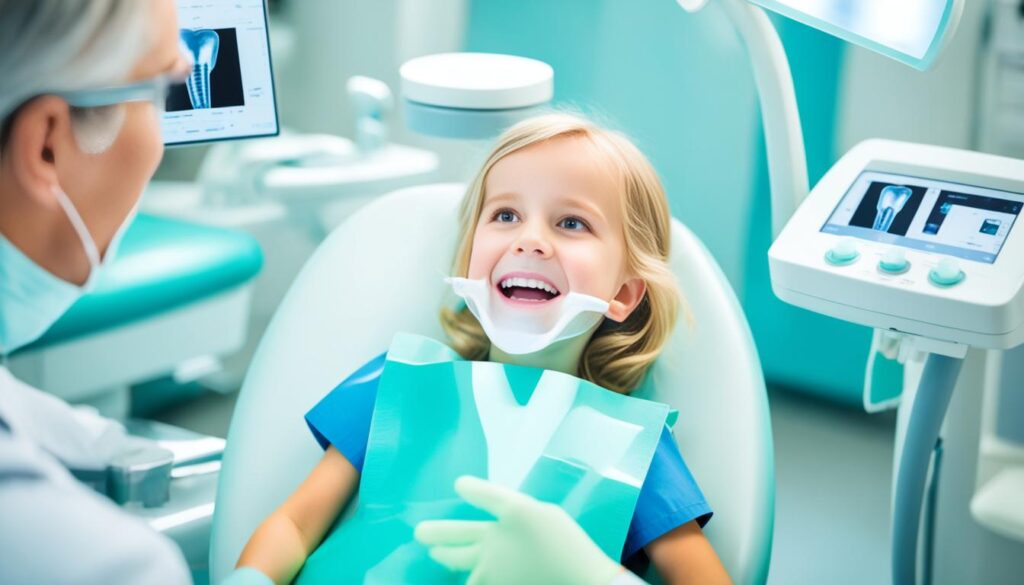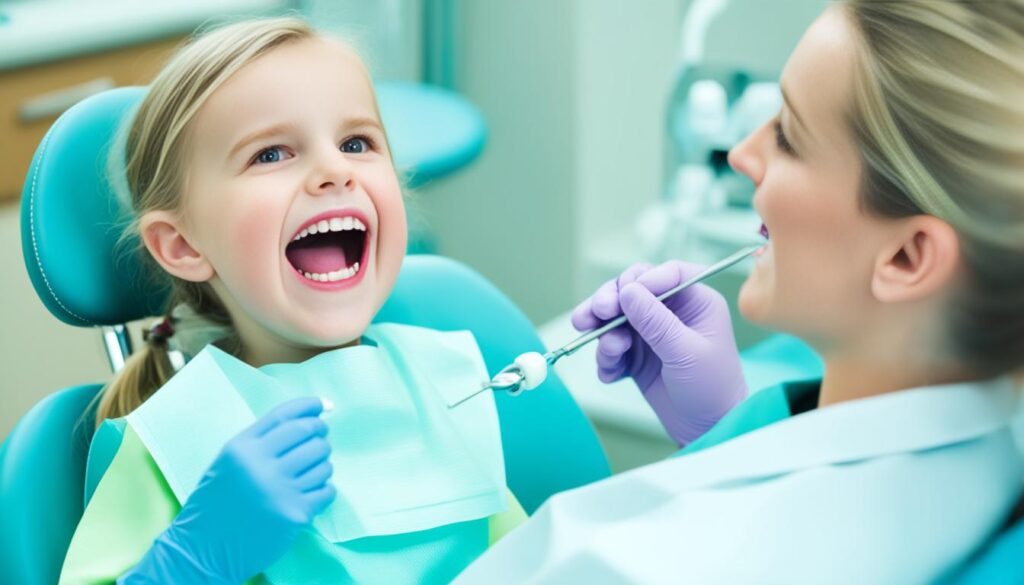Did you know that children have 20 primary (baby) teeth and typically start losing them around the age of 6?

Taking care of these teeth is crucial for their overall oral health and development. Pediatric dentistry focuses on providing specialized dental treatments for children, ensuring their smiles stay bright and healthy.
Let’s explore some of the most common dental procedures performed in pediatric dentistry and why they are important for your child’s dental care.
Key Takeaways:
- Pediatric dentistry offers specialized dental treatments for children.
- Stainless steel crowns are commonly used to restore badly decayed back teeth in young children.
- Tooth-colored fillings are used to repair fractured teeth and areas of decay, providing a natural-looking restoration.
- X-rays play a crucial role in pediatric dentistry, allowing dentists to detect and address potential issues early on.
- Regular dental cleanings are essential to remove plaque and protect against cavities and gum disease.
Stainless Steel Crowns
Stainless steel crowns are a commonly used dental procedure for young children who require extensive tooth restoration. These crowns are particularly effective in restoring badly decayed back teeth in primary dentition. When the decay has caused significant damage to the tooth, tooth-colored fillings may not be a suitable option.
Instead, pediatric dentists often use prefabricated silver-colored crowns made of stainless steel. These crowns are cemented onto the primary teeth to prevent further damage and preserve tooth structure until the natural exfoliation of the primary teeth. Stainless steel crowns are durable, cost-effective, and offer excellent protection for children’s teeth.

Stainless steel crowns are the go-to solution for dental services for kids when restoration is required on extensively decayed back teeth. The use of stainless steel crowns ensures that young children can regain the function and esthetics of their teeth, contributing to their overall oral health and well-being.
Moreover, stainless steel crowns are less time-consuming compared to other extensive restorative procedures, such as ceramic crowns. The simplicity of placement and minimal chair time make stainless steel crowns an excellent choice for dental procedures for young children.
Stainless steel crowns are a durable and effective solution for young children who require extensive tooth restoration.
Table: Comparison between Stainless Steel Crowns and Tooth-Colored Fillings
| Features | Stainless Steel Crowns | Tooth-Colored Fillings |
|---|---|---|
| Material | Stainless Steel | Composite resin |
| Esthetics | Silver-colored | Color-matched to natural teeth |
| Restoration Type | Extensively decayed back teeth | Front or back teeth |
| Strength and Durability | High | Lower |
| Cost | Relatively low | Higher |
As seen in the table above, stainless steel crowns and tooth-colored fillings have their unique attributes. While stainless steel crowns are primarily used for extensive restorations in back teeth, tooth-colored fillings are ideal for both front and back teeth where esthetics is a concern.
Consulting a pediatric dentist is essential to determine the most suitable dental procedure for young children. Together with their expertise, stainless steel crowns can play a significant role in restoring the oral health and smiles of children.
Tooth Colored Fillings
Tooth colored fillings are a popular choice for dental treatments in young patients, especially when cosmetic appearance is important. These kid-friendly dental procedures use composite resin fillings to repair fractured teeth and areas of decay, ensuring both oral health and a natural-looking smile.
Unlike traditional silver fillings, tooth colored fillings are made to match the natural color of the patient’s teeth. The shade of the filling material is carefully selected and matched as closely as possible to create a seamless restoration. This makes the fillings virtually indistinguishable from the surrounding tooth structure, resulting in a more aesthetically pleasing outcome.
With tooth colored fillings, children can feel confident in their smiles and avoid the embarrassment often associated with visible dental work. These fillings are a great option for restoring both front and back teeth, providing long-lasting results and preserving the overall beauty of a child’s dental appearance.
The Advantages of Tooth Colored Fillings:
- Improved Aesthetics: The natural color of tooth colored fillings makes them virtually invisible, ensuring a seamless and natural-looking restoration.
- Kid-Friendly: The use of composite resin fillings makes these dental procedures less intimidating for young patients, creating a more comfortable and relaxed dental experience.
- Preservation of Tooth Structure: Tooth colored fillings bond directly to the teeth, requiring less removal of healthy tooth structure compared to traditional silver fillings.
- Reduced Sensitivity: Tooth colored fillings are less likely to cause temperature sensitivity, offering increased comfort for young patients.
Overall, tooth colored fillings are a safe and effective option for dental treatments in young patients. They not only restore dental health but also contribute to the overall well-being and confidence of children. If your child requires dental restoration, speak to a pediatric dentist about the benefits of tooth colored fillings.

X-Rays (Radiographs)
In pediatric dentistry, X-rays, also known as radiographs, are an essential tool for evaluating and maintaining a child’s oral health. These diagnostic images reveal crucial information about the growth and development of a child’s teeth, helping dentists make accurate assessments and provide appropriate treatments.
Children require more frequent X-rays than adults because their mouths are still growing and changing. By capturing images of the teeth and surrounding structures, X-rays can detect potential issues that may not be visible to the naked eye, such as tooth decay, cavities, abscesses, and abnormalities in tooth alignment.
One of the most significant advantages of using X-rays in pediatric dentistry is early detection. By identifying problems at an early stage, dentists can implement preventive measures and address potential issues before they worsen. This proactive approach not only ensures optimal oral health but also helps minimize the need for extensive treatments in the future.
Digital radiography, a modern method of capturing X-ray images with low radiation levels, is commonly employed in pediatric dental practices. This technology provides clearer and more detailed images while minimizing exposure to radiation, making it safer for children.
During a dental visit, X-rays may be taken periodically to monitor the progress of ongoing treatments, assess tooth eruption patterns, and evaluate the overall oral health of the child. By incorporating X-rays into pediatric dental procedures, dentists can deliver comprehensive and individualized oral care for children.

Benefits of X-rays in Pediatric Dentistry:
- Early detection of dental issues
- Accurate assessment of tooth development
- Identification of hidden tooth decay and cavities
- Evaluation of bone health and alignment
- Monitoring the progress of ongoing treatments
Types of X-rays Used in Pediatric Dentistry:
| Type of X-ray | Description |
|---|---|
| Bitewing X-rays | Used to assess decay between the teeth and evaluate crowns or fillings |
| Periapical X-rays | Capture images of the entire tooth, including the root and supporting bone structure |
| Panoramic X-rays | Provide a broad view of the entire oral cavity, including the jaws, teeth, and supporting structures |
| Cephalometric X-rays | Used to analyze the relationship between the teeth, jaws, and facial bones |
With the help of X-rays, pediatric dental professionals can ensure early intervention and personalized treatment plans to maintain optimal oral health in children. Regular X-rays, combined with other preventive measures and dental treatments for children, play a vital role in preserving their developing smiles.
Dental Cleaning (Prophylaxis)
Regular dental cleanings are an essential part of pediatric dental care. During a dental visit, a dental assistant or hygienist will review your child’s medical history and examine their mouth for overall oral health. This examination allows the dental professional to identify any potential issues and provide appropriate treatments.
The teeth are then thoroughly cleaned to remove plaque and calculus, which can lead to cavities and gum disease. The cleaning process involves using specialized tools to remove stubborn plaque and tartar buildup from the teeth and along the gumline. This helps prevent tooth decay and gum inflammation, promoting optimal oral health.
In addition to cleaning, fluoride treatment is often applied to strengthen the teeth and protect against decay. Fluoride is a mineral that helps to remineralize the tooth surface, making it more resistant to acid attacks from bacteria. This treatment helps to prevent cavities and maintain the overall health of your child’s teeth.
To ensure ongoing oral health, it is recommended that children visit the pediatric dentist every six months for a dental evaluation and cleaning. These regular check-ups are crucial for detecting any potential issues early on and providing necessary treatments. By maintaining regular dental cleanings and check-ups, you can help keep your child’s smile healthy and brigh

